engine MITSUBISHI ECLIPSE CROSS 2018 (in English) Owner's Guide
[x] Cancel search | Manufacturer: MITSUBISHI, Model Year: 2018, Model line: ECLIPSE CROSS, Model: MITSUBISHI ECLIPSE CROSS 2018Pages: 417, PDF Size: 74.06 MB
Page 41 of 417
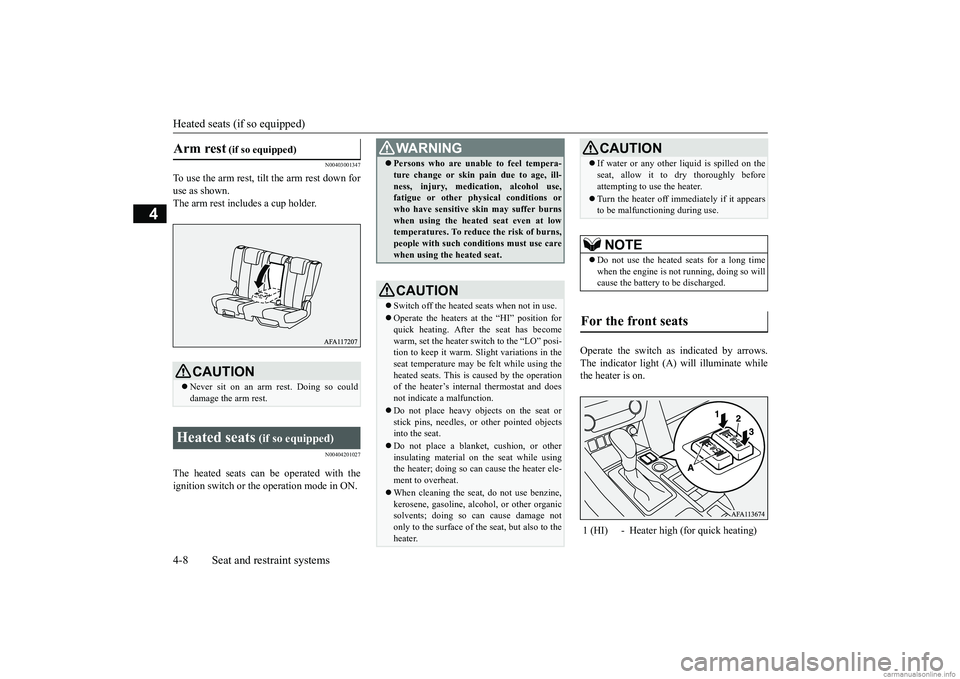
Heated seats (if so equipped) 4-8 Seat and restraint systems
4
N00403001347
To use the arm rest, tilt the arm rest down for use as shown.The arm rest includes a cup holder.
N00404201027
The heated seats can be operated with the ignition switch or the operation mode in ON.
Operate the switch as indicated by arrows. The indicator light (A) will illuminate while the heater is on.
Arm rest
(if so equipped)
CAUTION Never sit on an arm rest. Doing so could damage the arm rest.
Heated seats
(if so equipped)
WA R N I N G Persons who are unable to feel tempera- ture change or skin pain due to age, ill- ness, injury, medication, alcohol use, fatigue or other physical conditions or who have sensitive skin may suffer burnswhen using the heated seat even at low temperatures. To reduce the risk of burns, people with such conditions must use carewhen using the heated seat.CAUTION Switch off the heated seats when not in use.Operate the heaters at the “HI” position for quick heating. After the seat has become warm, set the heater switch to the “LO” posi-tion to keep it warm. Slight variations in the seat temperature may be felt while using the heated seats. This is caused by the operationof the heater’s internal thermostat and does not indicate a malfunction. Do not place heavy objects on the seat or stick pins, needles, or other pointed objects into the seat. Do not place a blanket,
cushion, or other
insulating material on the seat while using the heater; doing so can cause the heater ele- ment to overheat. When cleaning the seat, do not use benzine, kerosene, gasoline, alcohol, or other organicsolvents; doing so can cause damage not only to the surface of the seat, but also to the heater.
If water or any other li
quid is spilled on the
seat, allow it to dry thoroughly before attempting to use the heater. Turn the heater off immediately if it appears to be malfunctioning during use.NOTE
Do not use the heated seats for a long time when the engine is not running, doing so will cause the battery to be discharged.
For the front seats
1 (HI) - Heater high (for quick heating)
CAUTION
BK0252700US.bo
ok 8 ページ 2017年10月4日 水曜日 午後4時54分
Page 42 of 417
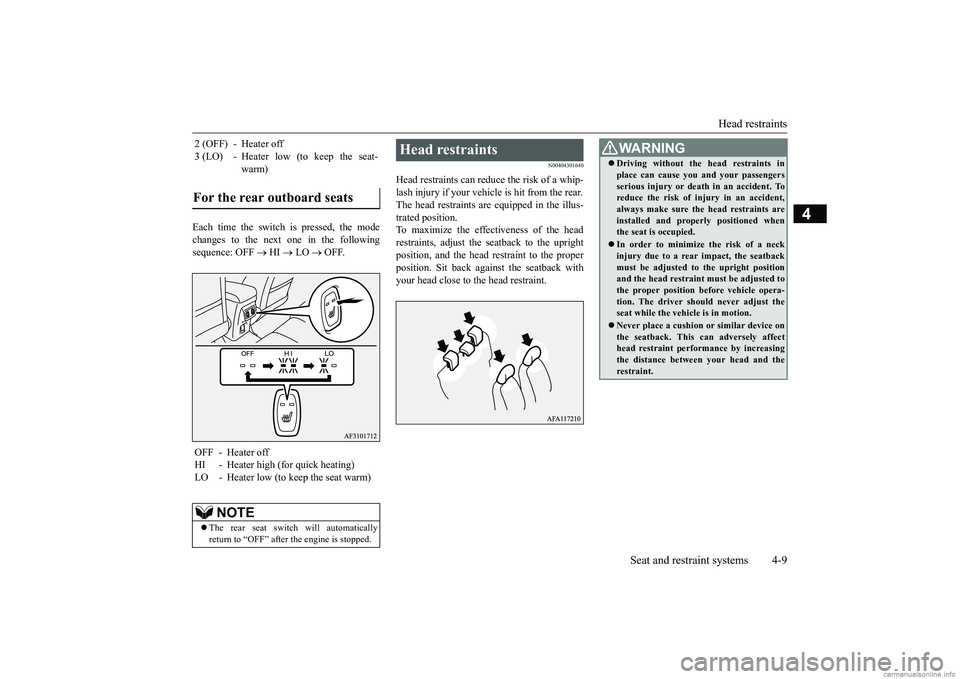
Head restraints
Seat and restraint systems 4-9
4
Each time the switch is pressed, the mode changes to the next one in the following sequence: OFF
HI
LO
OFF.
N00404301640
Head restraints can reduce the risk of a whip- lash injury if your vehicle is hit from the rear.The head restraints are equipped in the illus- trated position. To maximize the effectiveness of the headrestraints, adjust the seatback to the upright position, and the head
restraint to the proper
position. Sit back against the seatback withyour head close to the head restraint.
2 (OFF) - Heater off 3 (LO) - Heater low (to keep the seat-
warm)
For the rear outboard seats
OFF - Heater offHI - Heater high (for quick heating) LO - Heater low (to keep the seat warm)
NOTE
The rear seat switch will automatically return to “OFF” after the engine is stopped.
Head restraints
WA R N I N G Driving without the head restraints in place can cause you and your passengers serious injury or death in an accident. To reduce the risk of injury in an accident, always make sure the head restraints areinstalled and properly positioned when the seat is occupied. In order to minimize the risk of a neck injury due to a rear impact, the seatback must be adjusted to the upright positionand the head restraint must be adjusted to the proper position before vehicle opera- tion. The driver should never adjust theseat while the vehicle is in motion. Never place a cushion or similar device on the seatback. This can adversely affect head restraint performance by increasing the distance between your head and therestraint.
BK0252700US.bo
ok 9 ページ 2017年10月4日 水曜日 午後4時54分
Page 80 of 417
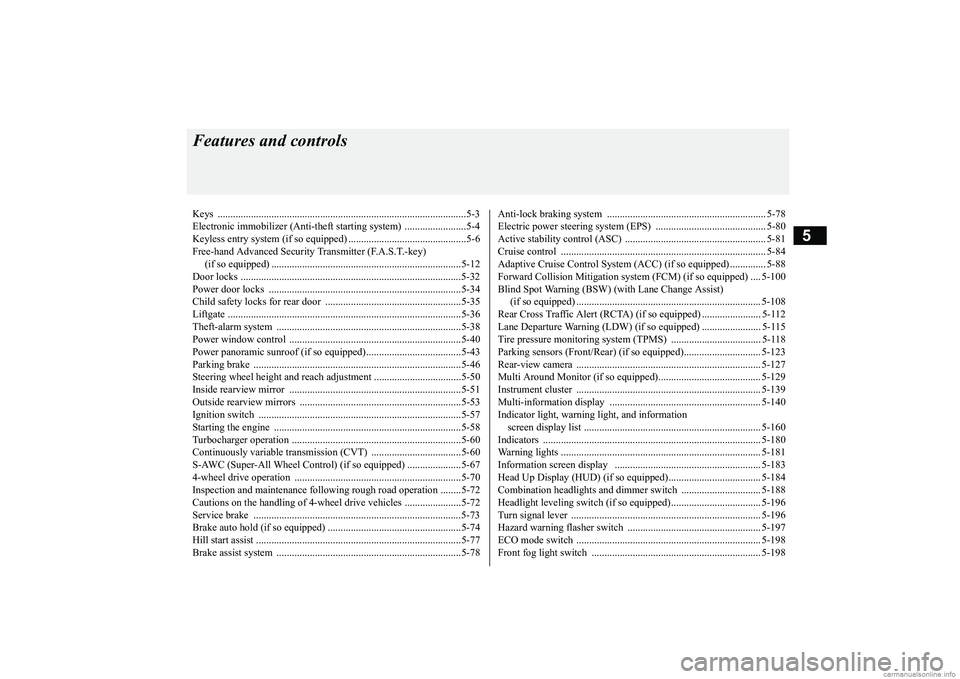
5
Features and controlsKeys ..........................................
.......................................................5-3
Electronic immobilizer (Anti-thef
t starting system) ........................5-4
Keyless entry system (if so equipped) ..............................................5-6 Free-hand Advanced Security Transmitter (F.A.S.T.-key) (if so equipped) .
.................................................
........................5-12
Door locks .......................
...............................................................5-32
Power door locks ............
...............................................................5-34
Child safety locks for r
ear door .....................................................5-35
Liftgate ......................................
.....................................................5-36
Theft-alarm system
................................................
........................5-38
Power window control
...........................................
........................5-40
Power panoramic sunroof (if
so equipped).....................................5-43
Parking brake ..................
...............................................................5-46
Steering wheel height and reach adjustment ..................................5-50 Inside rearview mirro
r ...........................................
........................5-51
Outside rearview mirr
ors ...............................................................5-53
Ignition switch ......
.................................................
........................5-57
Starting the engine
.................................................
........................5-58
Turbocharger operation
..........................................
........................5-60
Continuously variable trans
mission (CVT) ...................................5-60
S-AWC (Super-All Wheel Control) (if so equipped) .....................5-67 4-wheel drive operation
.........................................
........................5-70
Inspection and maintenance following rough road operation ........5-72Cautions on the handling of 4-wheel drive vehicles ......................5-72 Service brake ..................
...............................................................5-73
Brake auto hold (if so
equipped) ....................................................5-74
Hill start assist .......
.................................................
........................5-77
Brake assist system
................................................
........................5-78
Anti-lock braking syst
em .....................................
......................... 5-78
Electric power steering syst
em (EPS) ........................................... 5-80
Active stability control
(ASC) ....................
................................... 5-81
Cruise control ................
.................................................
............... 5-84
Adaptive Cruise Control System (ACC) (if so equipped) .............. 5-88 Forward Collision Mitigation system (FCM) (if so equipped) .... 5-100 Blind Spot Warning (BSW) (with Lane Change Assist) (if so equipped) ..........
.................................................
............. 5-108
Rear Cross Traffic Alert (RCTA) (if so equipped) ....................... 5-112 Lane Departure Warning (LDW) (if so equipped) ....................... 5-115Tire pressure monitoring system (TPMS) ................................... 5-118 Parking sensors (Front/Rear)
(if so equipped).............................. 5-123
Rear-view camera ..........
.................................................
............. 5-127
Multi Around Monitor (if so
equipped)........................................ 5-129
Instrument cluster
.................................................
....................... 5-139
Multi-information disp
lay ....................................
....................... 5-140
Indicator light, warning light, and information screen display list
..............................................
....................... 5-160
Indicators .................................
.................................................... 5-180
Warning lights ................
.................................................
............. 5-181
Information screen disp
lay ........................
................................. 5-183
Head Up Display (HUD) (if
so equipped).................................... 5-184
Combination headlights and dimmer switch ............................... 5-188Headlight leveling switch (if
so equipped)................................... 5-196
Turn signal lever ..
.................................................
....................... 5-196
Hazard warning flasher
switch .................................................... 5-197
ECO mode switch ..........
.................................................
............. 5-198
Front fog light switch
...........................................
....................... 5-198
BK0252700US.bo
ok 1 ページ 2017年10月4日 水曜日 午後4時54分
Page 83 of 417
![MITSUBISHI ECLIPSE CROSS 2018 (in English) Owners Guide Electronic immobilizer (Anti-theft starting system) 5-4 Features and controls
5
N00509101905
[For vehicles equipped with the F.A.S.T.-key] For information on operations for vehiclesequipped with the F MITSUBISHI ECLIPSE CROSS 2018 (in English) Owners Guide Electronic immobilizer (Anti-theft starting system) 5-4 Features and controls
5
N00509101905
[For vehicles equipped with the F.A.S.T.-key] For information on operations for vehiclesequipped with the F](/img/19/34869/w960_34869-82.png)
Electronic immobilizer (Anti-theft starting system) 5-4 Features and controls
5
N00509101905
[For vehicles equipped with the F.A.S.T.-key] For information on operations for vehiclesequipped with the F.A.S.T.-key, refer to “Free-hand Advanced Security Transmitter
(F.A.S.T.-key): Electronic immobilizer (Anti- theft starting system)” on page 5-17. [Except for vehicles equipped with the F. A . S . T. - k e y ] The electronic immobilizer is designed to sig-nificantly reduce the possibility of vehicle theft. The purpose of the system is to immo- bilize the vehicle if an invalid start isattempted. A valid start attempt can only be achieved (subject to certain conditions) using a key “registered” to the immobilizer system.All of the keys provided with your new vehi-cle have been programmed to the vehicle’s electronics.
No keys other than those registered in advance can be used to start the engine. Refer to “Electronic immobilizer (Anti-theft starting system)” on page 5-4. Refer to “Free-hand Advanced SecurityTransmitter (F.A.S.T.-key): “Electronic immobilizer (Anti-theft starting system)” on page 5-17. When the theft-alarm is in the system opera- tional status, the alarm operates if a door orliftgate is opened after using the key, the door lock knob or the power door lock switch to unlock the vehicle. The system does not enter the preparation state if the keyless entry system or theF.A.S.T.-key was not used to lock the vehi- cle.
Electronic immobilizer (Anti-theft starting system)
CAUTION Do not make any alterations or additions to the immobilizer system. Alterations or addi- tions could cause failure of the immobilizer.NOTE
NOTE
In the following cases, the vehicle may not be able to recognize the registered ID codefrom the key. This means the engine will not start even when the ke
y is turned to the
“START” position. • When the key contacts a key ring or other metallic or magnetic object
• When the key grip contacts metal of another key • When the key contacts or is close to other immobilizer keys (including keys of other vehicles) In cases like the above, move the offending object(s) away from the key and turn the key back to the “ACC” or “OFF” position. Thentry to start the engine again. If the engine does not start, contact an authorized Mitsubishi Motors dealer. The key may not operate properly when it is near an object or fac
ility that emits strong
electromagnetic waves.NOTE
BK0252700US.bo
ok 4 ページ 2017年10月4日 水曜日 午後4時54分
Page 84 of 417
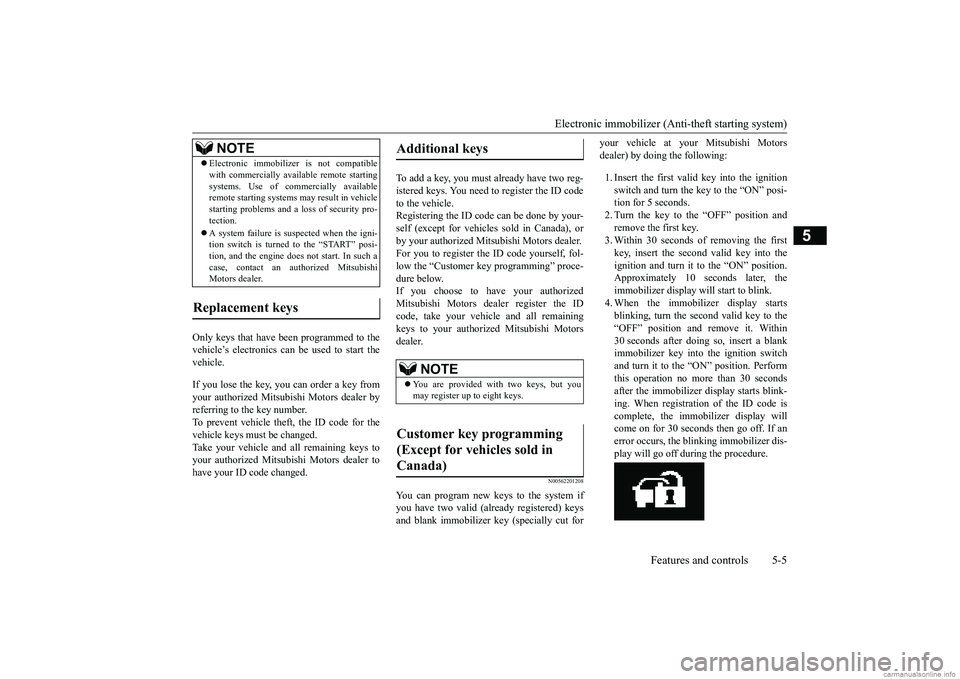
Electronic immobilizer (Ant
i-theft starting system)
Features and controls 5-5
5
Only keys that have been programmed to the vehicle’s electronics can be used to start the vehicle. If you lose the key, you can order a key from your authorized Mitsubishi Motors dealer by referring to the key number. To prevent vehicle theft, the ID code for thevehicle keys must be changed. Take your vehicle and all remaining keys to your authorized Mitsubishi Motors dealer tohave your ID code changed.
To add a key, you must already have two reg- istered keys. You need to register the ID codeto the vehicle. Registering the ID code can be done by your- self (except for vehicles sold in Canada), orby your authorized Mitsubishi Motors dealer. For you to register the ID code yourself, fol- low the “Customer key programming” proce-dure below.If you choose to have your authorized Mitsubishi Motors dealer register the ID code, take your vehicle and all remainingkeys to your authorized Mitsubishi Motors dealer.
N00562201208
You can program new keys to the system if you have two valid (already registered) keysand blank immobilizer key (specially cut for
your vehicle at your Mitsubishi Motors dealer) by doing the following: 1. Insert the first valid key into the ignition switch and turn the key to the “ON” posi- tion for 5 seconds.2. Turn the key to the “OFF” position and remove the first key. 3. Within 30 seconds of removing the firstkey, insert the second valid key into the ignition and turn it to the “ON” position. Approximately 10 seconds later, theimmobilizer display will start to blink.4. When the immobilizer display starts blinking, turn the second valid key to the “OFF” position and remove it. Within30 seconds after doing so, insert a blank immobilizer key into the ignition switch and turn it to the “ON” position. Performthis operation no more than 30 seconds after the immobilizer display starts blink- ing. When registration of the ID code iscomplete, the immobilizer display will come on for 30 seconds then go off. If an error occurs, the blinking immobilizer dis-play will go off during the procedure.
Electronic immobilizer is not compatible with commercially available remote starting systems. Use of commercially available remote starting systems may result in vehicle starting problems and a loss of security pro-tection. A system failure is suspected when the igni- tion switch is turned to the “START” posi- tion, and the engine does not start. In such a case, contact an authorized MitsubishiMotors dealer.
Replacement keys
NOTE
Additional keys
NOTE
You are provided with two keys, but you may register up to eight keys.
Customer key programming (Except for vehicles sold in Canada)
BK0252700US.bo
ok 5 ページ 2017年10月4日 水曜日 午後4時54分
Page 91 of 417
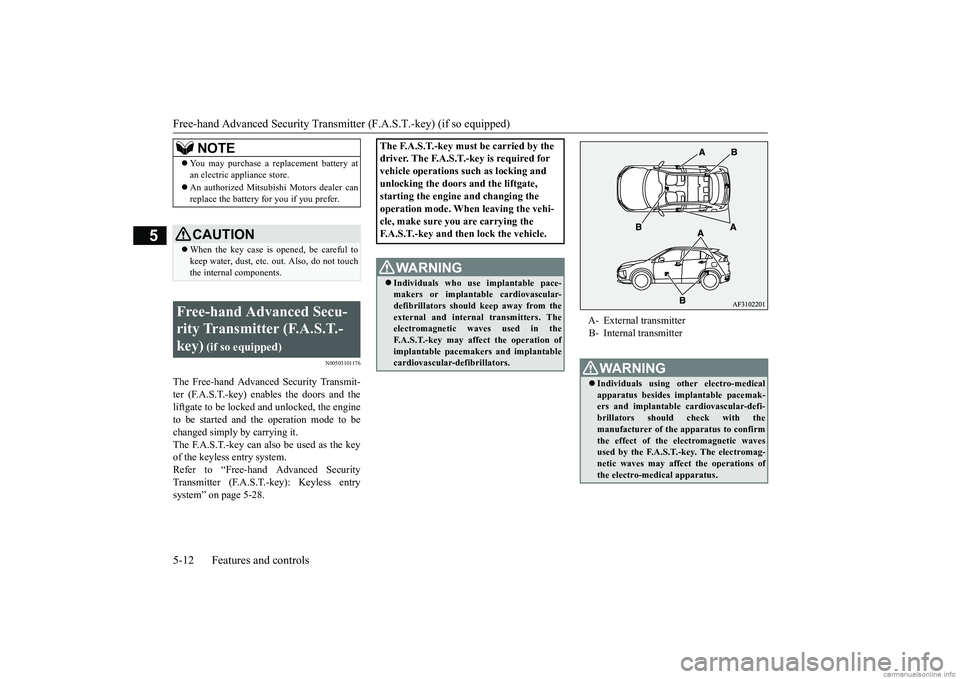
Free-hand Advanced Security Transmitter (F.A.S.T.-key) (if so equipped) 5-12 Features and controls
5
N00503101176
The Free-hand Advanced Security Transmit- ter (F.A.S.T.-key) enables the doors and the liftgate to be locked and unlocked, the engineto be started and the operation mode to be changed simply by carrying it. The F.A.S.T.-key can also be used as the keyof the keyless entry system. Refer to “Free-hand Advanced Security Transmitter (F.A.S.T.-key): Keyless entrysystem” on page 5-28.
NOTE
You may purchase a replacement battery at an electric appliance store. An authorized Mitsubishi Motors dealer can replace the battery for you if you prefer.CAUTION When the key case is opened, be careful to keep water, dust, etc. out. Also, do not touch the internal components.
Free-hand Advanced Secu- rity Transmitter (F.A.S.T.-key)
(if so equipped)
The F.A.S.T.-key must be carried by the driver. The F.A.S.T.-key is required for vehicle operations such as locking and unlocking the doors and the liftgate, starting the engine and changing the operation mode. When leaving the vehi-cle, make sure you are carrying the F.A.S.T.-key and then lock the vehicle.
WA R N I N G Individuals who use implantable pace- makers or implantable cardiovascular-defibrillators should keep away from the external and internal
transmitters. The
electromagnetic waves used in theF.A.S.T.-key may affect the operation of implantable pacemakers and implantable cardiovascular-defibrillators.
A- External transmitter B- Internal transmitterWA R N I N G Individuals using other electro-medical apparatus besides implantable pacemak-ers and implantable cardiovascular-defi- brillators should check with the manufacturer of the apparatus to confirm the effect of the electromagnetic waves used by the F.A.S.T.-key. The electromag-netic waves may affect the operations of the electro-medical apparatus.
BK0252700US.bo
ok 12 ページ 2017年10月4日 水曜日 午後4時54分
Page 92 of 417
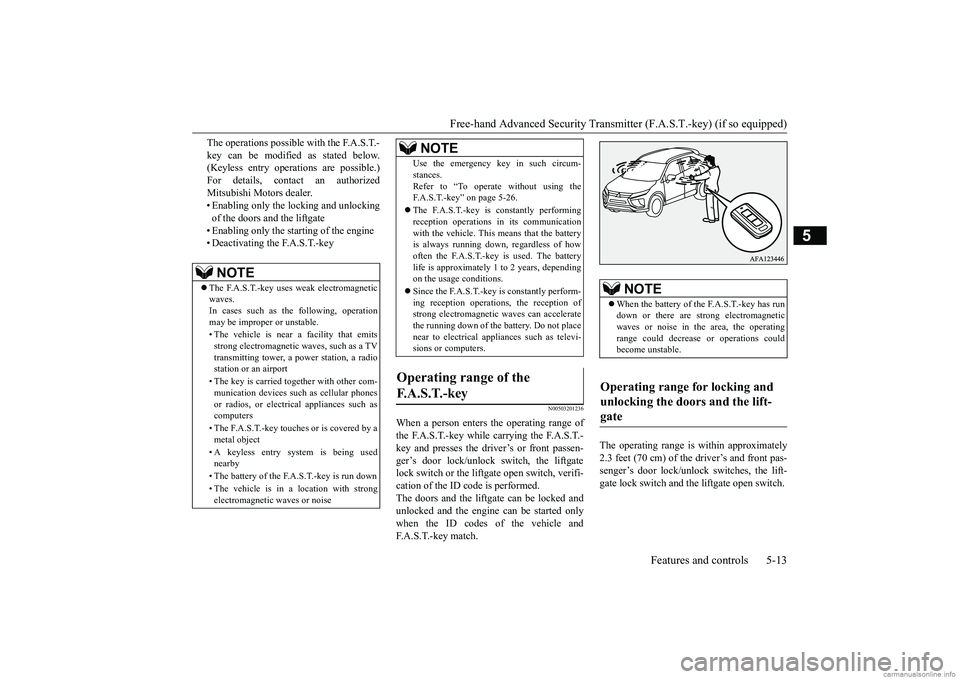
Free-hand Advanced Security Transmit
ter (F.A.S.T.-key) (if so equipped)
Features and controls 5-13
5
The operations possible with the F.A.S.T.- key can be modified as stated below. (Keyless entry operations are possible.) For details, contact an authorizedMitsubishi Motors dealer. • Enabling only the locking and unlocking of the doors and the liftgate• Enabling only the starting of the engine • Deactivating the F.A.S.T.-key
N00503201236
When a person enters the operating range ofthe F.A.S.T.-key while carrying the F.A.S.T.- key and presses the driver’s or front passen-ger’s door lock/unlock switch, the liftgate lock switch or the liftgate open switch, verifi- cation of the ID code is performed.The doors and the liftgate can be locked and unlocked and the engine can be started only when the ID codes of the vehicle andF.A.S.T.-key match.
The operating range is within approximately 2.3 feet (70 cm) of the driver’s and front pas- senger’s door lock/unlock switches, the lift- gate lock switch and the liftgate open switch.
NOTE
The F.A.S.T.-key uses weak electromagnetic waves. In cases such as the following, operation may be improper or unstable. • The vehicle is near a facility that emits strong electromagnetic waves, such as a TVtransmitting tower, a power station, a radio station or an airport • The key is carried together with other com- munication devices such as cellular phones or radios, or electrical appliances such ascomputers • The F.A.S.T.-key touches or is covered by a metal object • A keyless entry system is being used nearby • The battery of the F.A.S.T.-key is run down • The vehicle is in a location with strong electromagnetic waves or noise
Use the emergency key in such circum- stances. Refer to “To operate without using the F.A.S.T.-key” on page 5-26. The F.A.S.T.-key is constantly performing reception operations in its communication with the vehicle. This means that the batteryis always running down, regardless of how often the F.A.S.T.-key is used. The battery life is approximately 1 to 2 years, dependingon the usage conditions. Since the F.A.S.T.-key is constantly perform- ing reception operations, the reception of strong electromagnetic waves can accelerate the running down of the battery. Do not placenear to electrical appliances such as televi- sions or computers.
Operating range of the F. A . S . T. - k e y
NOTE
NOTE
When the battery of the F.A.S.T.-key has run down or there are strong electromagnetic waves or noise in the area, the operating range could decrease or operations couldbecome unstable.
Operating range for locking and unlocking the doors and the lift- gate
BK0252700US.bo
ok 13 ページ 2017年10月4日 水曜日 午後4時54分
Page 93 of 417
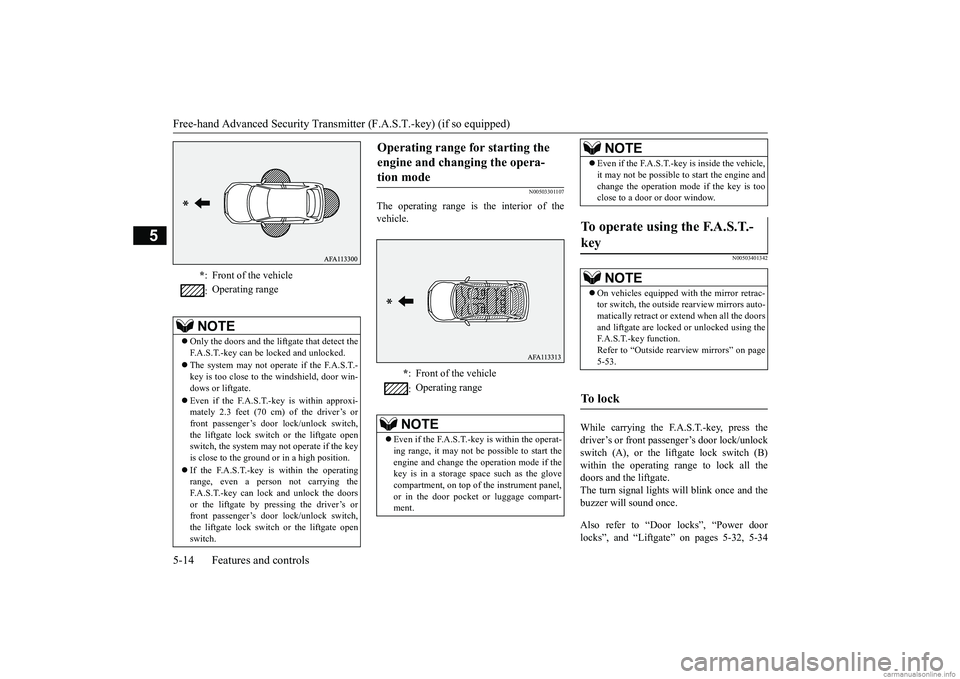
Free-hand Advanced Security Transmitter (F.A.S.T.-key) (if so equipped) 5-14 Features and controls
5
N00503301107
The operating range is the interior of the vehicle.
N00503401342
While carrying the F.A.S.T.-key, press thedriver’s or front passenger’s door lock/unlock switch (A), or the liftgate lock switch (B) within the operating range to lock all thedoors and the liftgate. The turn signal lights will blink once and the buzzer will sound once. Also refer to “Door locks”, “Power door locks”, and “Liftgate” on pages 5-32, 5-34
* : Front of the vehicle : Operating range
NOTE
Only the doors and the liftgate that detect the F.A.S.T.-key can be locked and unlocked. The system may not operate if the F.A.S.T.- key is too close to the windshield, door win- dows or liftgate. Even if the F.A.S.T.-key is within approxi- mately 2.3 feet (70 cm) of the driver’s or front passenger’s door lock/unlock switch,the liftgate lock switch or the liftgate open switch, the system may not operate if the key is close to the ground or in a high position. If the F.A.S.T.-key is within the operating range, even a person not carrying theF.A.S.T.-key can lock and unlock the doors or the liftgate by pressing the driver’s or front passenger’s door lock/unlock switch,the liftgate lock switch or the liftgate open switch.
Operating range for starting the engine and changing the opera- tion mode
* : Front of the vehicle : Operating range
NOTE
Even if the F.A.S.T.-key is within the operat- ing range, it may not be possible to start theengine and change the operation mode if the key is in a storage space such as the glove compartment, on top of
the instrument panel,
or in the door pocket or luggage compart- ment.
Even if the F.A.S.T.-key is inside the vehicle, it may not be possible to start the engine and change the operation mode if the key is too close to a door or door window.
To operate using the F.A.S.T.- key
NOTE
On vehicles equipped with the mirror retrac- tor switch, the outside rearview mirrors auto- matically retract or extend when all the doors and liftgate are locked or unlocked using theF.A.S.T.-key function. Refer to “Outside rearview mirrors” on page 5-53.
To l o c k
NOTE
BK0252700US.bo
ok 14 ページ 2017年10月4日 水曜日 午後4時54分
Page 97 of 417
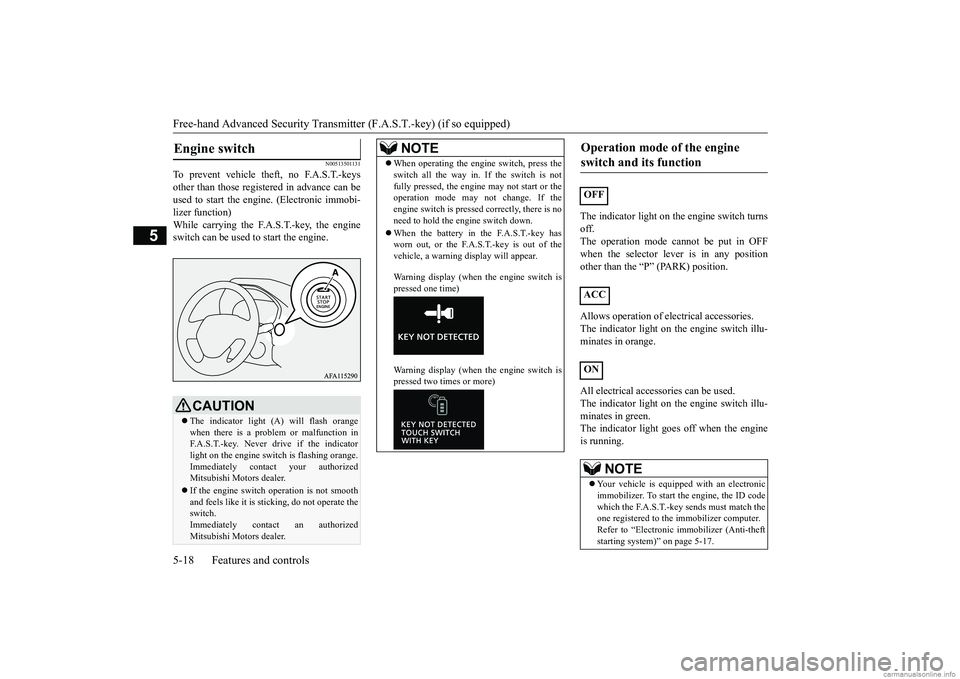
Free-hand Advanced Security Transmitter (F.A.S.T.-key) (if so equippe\
d)
5-18 Features and controls
5
N00513501131
To prevent vehicle theft, no F.A.S.T.-keys
other than those registered in advance can be
used to start the engine. (Electronic immobi-
lizer function)
While carrying the F.A.S.T.-key, the engine
switch can be used to start the engine.The indicator light on the engine switch turns
off.
The operation mode cannot be put in OFF
when the selector lever is in any position
other than the “P” (PARK) position.
Allows operation of electrical accessories.
The indicator light on the engine switch illu-
minates in orange.
All electrical accessories can be used.
The indicator light on the engine switch illu-
minates in green.
The indicator light goes off when the engine
is running.Engine switch
CAUTION
The indicator light (A) will flash orange
when there is a problem or malfunction in
F.A.S.T.-key. Never drive if the indicator
light on the engine switch is flashing orange.
Immediately contact your authorized
Mitsubishi Motors dealer.If the engine switch operation is not smooth
and feels like it is sticking, do not operate the
switch.
Immediately contact an authorized
Mitsubishi Motors dealer.
NOTE
When operating the engine switch, press the
switch all the way in. If the switch is not
fully pressed, the engine may not start or the
operation mode may not change. If the
engine switch is pressed correctly, there is no
need to hold the engine switch down.
When the battery in the F.A.S.T.-key has
worn out, or the F.A.S.T.-key is out of the
vehicle, a warning display will appear.
Warning display (when the engine switch is
pressed one time)
Warning display (when the engine switch is
pressed two times or more)
Operation mode of the engine
switch and its function
OFF
ACC
ON
NOTE
Your vehicle is equipped with an electronic
immobilizer. To start the engine, the ID code
which the F.A.S.T.-key sends must match the
one registered to the immobilizer computer.
Refer to “Electronic immobilizer (Anti-theft
starting system)” on page 5-17.
BK0252700US.bo ok 18 ページ 2017年10月5日 木曜日 午後6時49分
Page 98 of 417
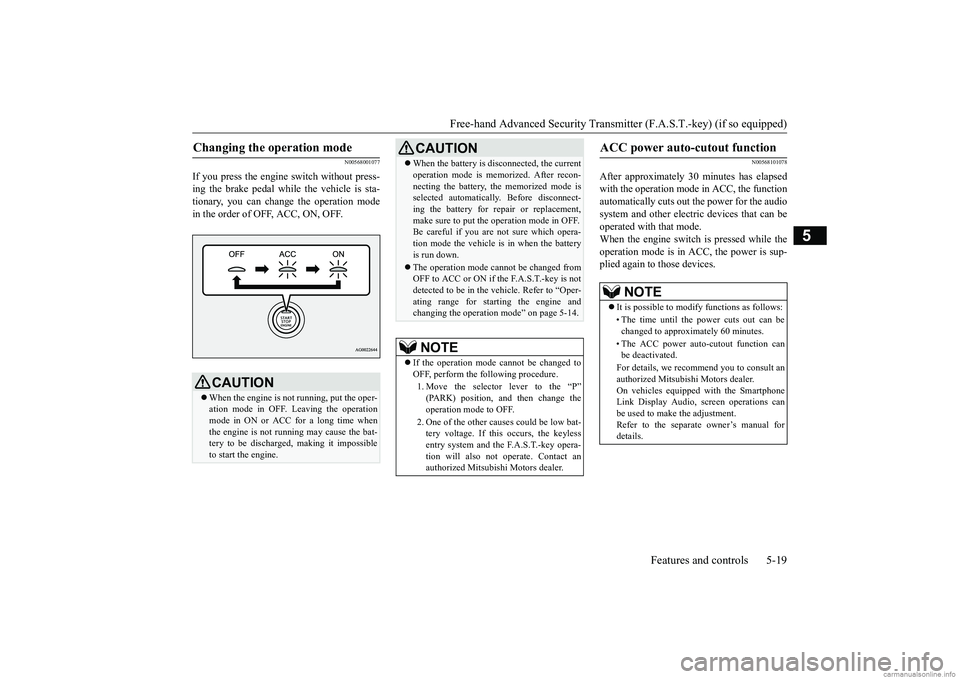
Free-hand Advanced Security Transmit
ter (F.A.S.T.-key) (if so equipped)
Features and controls 5-19
5
N00568001077
If you press the engine switch without press- ing the brake pedal while the vehicle is sta-tionary, you can change the operation mode in the order of OFF, ACC, ON, OFF.
N00568101078
After approximately 30 minutes has elapsed with the operation mode in ACC, the functionautomatically cuts out the power for the audio system and other electri
c devices that can be
operated with that mode.When the engine switch is pressed while the operation mode is in ACC, the power is sup- plied again to those devices.
Changing the operation mode
CAUTION When the engine is not running, put the oper- ation mode in OFF. Leaving the operationmode in ON or ACC for a long time when the engine is not running may cause the bat- tery to be discharged, making it impossibleto start the engine.
When the battery is disconnected, the current operation mode is memorized. After recon- necting the battery, the memorized mode is selected automatically. Before disconnect- ing the battery for repair or replacement,make sure to put the operation mode in OFF. Be careful if you are not sure which opera- tion mode the vehicle is in when the batteryis run down. The operation mode cannot be changed from OFF to ACC or ON if the F.A.S.T.-key is not detected to be in the vehicle. Refer to “Oper- ating range for starting the engine andchanging the operation mode” on page 5-14.NOTE
If the operation mode cannot be changed to OFF, perform the following procedure. 1. Move the selector lever to the “P” (PARK) position, and then change the operation mode to OFF. 2. One of the other causes could be low bat- tery voltage. If this occurs, the keylessentry system and the F.A.S.T.-key opera- tion will also not operate. Contact an authorized Mitsubishi Motors dealer.CAUTION
ACC power auto-cutout function
NOTE
It is possible to modify functions as follows: • The time until the power cuts out can be changed to approximately 60 minutes. • The ACC power auto-cutout function can be deactivated. For details, we recommend you to consult an authorized Mitsubishi Motors dealer. On vehicles equipped with the SmartphoneLink Display Audio, screen operations can be used to make the adjustment. Refer to the separate owner’s manual fordetails.
BK0252700US.bo
ok 19 ページ 2017年10月4日 水曜日 午後4時54分